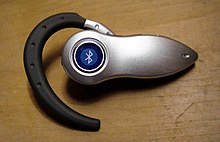Bluethoot
An example of a Bluetooth device is a wireless headset
In computer science, Bluetooth is a proprietary open standard for wireless communication connecting two or more electronic devices, such as a mobile phone, PDA, personal computer, or wireless headphones. It was created in 1994 by Ericsson as a wireless replacement for the RS-232 serial wired interface.
Individual devices are identified by their BD_ADDR(BlueTooth Device Address) similar to the MAC ADDRESS and in the Ethernett network.
The name Bluetooth is derived from the English name of the Danish king Harald Bluetooth (bluetooth means "Bluetooth" in English), who ruled in the 10th century. He used his diplomatic skills to get the warring tribes to come to a discussion and end their differences. This analogy was used for the name of Bluetooth technology, which, like King Harald once, serves to facilitate mutual communication.
Specifications
Bluetooth technology is defined by the IEEE 802.15.1 standard. It belongs to the category of personal computer networks, so-called Personal Area Network (PAN). It exists in several versions, the last one (March 2014) is currently version 4.0 or 4.1, which is equipped with the majority of sold devices such as e.g. mobile phones, laptops, tablets, but also television.
On December 4, 2013, version 4.1 was officially launched, with a software update available for hardware version 4.0.
Bluetooth and WIFI
In terms of implementation, Wi-Fi with Bluetooth is similar to the so-called ad-hoc way of communication. Wi-Fi works on the link layer of the ISO/OSI network model, it does not care about the type of protocol being transmitted. On the other hand, Bluetooth itself solves higher, up to the application layers of the network model. It follows that for each type of connectable device Bluetooth must have a special protocol defined to communicate with it. This method complicates the development of Bluetooth software support (i.e. the device driver), but also the compatibility of individual implementations, which may contain errors that cause communication to be non-functional. On the other hand, however, they simplify the development of the software used by the given device and the configuration of individual devices to be connected.
Connection setup
All Bluetooth devices in visibility mode transmit the following information upon request:
Device name
Device class
List of services
Technical information (eg: device features, manufacturer, Bluetooth specification used)
Any device can search for other devices, and each device can be configured to respond to different queries. However, if the device tries to connect to a known device, it always responds to direct connection requests. If the device is unknown, it will ask to send back the information listed above. Services used by the device may require pairing or confirmation from the device owner. Any device can initiate and establish a connection as long as it is within Bluetooth range. Each device has a unique 48-bit address. These addresses are not usually displayed. Instead, names that can be set by the user are used. This name is displayed when the user searches for a device in the list of paired devices. By default, most phones have a name set to the manufacturer and model of the phone. Special programs can get additional information about remote devices, and it can be confusing when there are several phones in range, for example T610 (see Bluejacking).
Pairing
Many of the offered Bluetooth services publish private data or control the connected Bluetooth device. For security reasons, it is necessary for it to be able to recognize a specific device and thus enable control over the device that can connect to the given Bluetooth. At the same time, it is advisable for the Bluetooth device to be able to establish a connection without user intervention (for example, as soon as it is within Bluetooth range). Bluetooth uses a process called "Pairing" to solve this problem. The pairing process is started either at a special request from the user creating the connection (eg: the user explicitly requests to add a Bluetooth device), or it is automatically started at the first connection to the service, where the first identification of the device is required for security reasons. These two links are referred to as single-purpose and general-purpose links. Pairing often involves some cooperation with the user, the basis of which is the confirmation of the identity of the device. After successful pairing, the connection between the two devices is established. These two devices can be connected in the future without the need for a new pairing process, without confirming the identity of these devices. If necessary, the automatic pairing process can be removed by the user.


